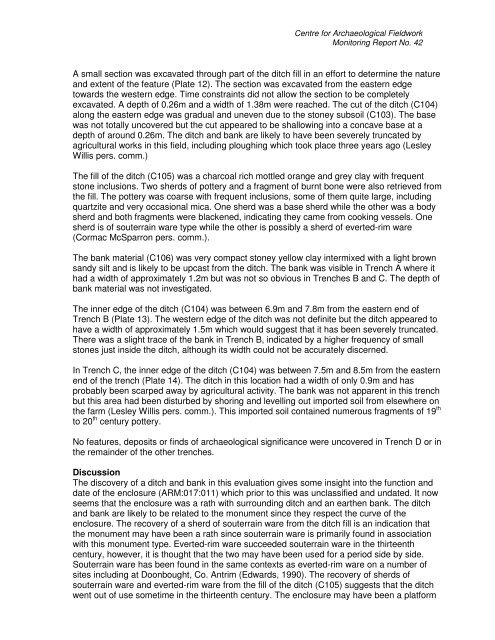Dinnahora - Co. Armagh
Dinnahora - Co. Armagh
Dinnahora - Co. Armagh
You also want an ePaper? Increase the reach of your titles
YUMPU automatically turns print PDFs into web optimized ePapers that Google loves.
Centre for Archaeological Fieldwork<br />
Monitoring Report No. 42<br />
A small section was excavated through part of the ditch fill in an effort to determine the nature<br />
and extent of the feature (Plate 12). The section was excavated from the eastern edge<br />
towards the western edge. Time constraints did not allow the section to be completely<br />
excavated. A depth of 0.26m and a width of 1.38m were reached. The cut of the ditch (C104)<br />
along the eastern edge was gradual and uneven due to the stoney subsoil (C103). The base<br />
was not totally uncovered but the cut appeared to be shallowing into a concave base at a<br />
depth of around 0.26m. The ditch and bank are likely to have been severely truncated by<br />
agricultural works in this field, including ploughing which took place three years ago (Lesley<br />
Willis pers. comm.)<br />
The fill of the ditch (C105) was a charcoal rich mottled orange and grey clay with frequent<br />
stone inclusions. Two sherds of pottery and a fragment of burnt bone were also retrieved from<br />
the fill. The pottery was coarse with frequent inclusions, some of them quite large, including<br />
quartzite and very occasional mica. One sherd was a base sherd while the other was a body<br />
sherd and both fragments were blackened, indicating they came from cooking vessels. One<br />
sherd is of souterrain ware type while the other is possibly a sherd of everted-rim ware<br />
(<strong>Co</strong>rmac McSparron pers. comm.).<br />
The bank material (C106) was very compact stoney yellow clay intermixed with a light brown<br />
sandy silt and is likely to be upcast from the ditch. The bank was visible in Trench A where it<br />
had a width of approximately 1.2m but was not so obvious in Trenches B and C. The depth of<br />
bank material was not investigated.<br />
The inner edge of the ditch (C104) was between 6.9m and 7.8m from the eastern end of<br />
Trench B (Plate 13). The western edge of the ditch was not definite but the ditch appeared to<br />
have a width of approximately 1.5m which would suggest that it has been severely truncated.<br />
There was a slight trace of the bank in Trench B, indicated by a higher frequency of small<br />
stones just inside the ditch, although its width could not be accurately discerned.<br />
In Trench C, the inner edge of the ditch (C104) was between 7.5m and 8.5m from the eastern<br />
end of the trench (Plate 14). The ditch in this location had a width of only 0.9m and has<br />
probably been scarped away by agricultural activity. The bank was not apparent in this trench<br />
but this area had been disturbed by shoring and levelling out imported soil from elsewhere on<br />
the farm (Lesley Willis pers. comm.). This imported soil contained numerous fragments of 19 th<br />
to 20 th century pottery.<br />
No features, deposits or finds of archaeological significance were uncovered in Trench D or in<br />
the remainder of the other trenches.<br />
Discussion<br />
The discovery of a ditch and bank in this evaluation gives some insight into the function and<br />
date of the enclosure (ARM:017:011) which prior to this was unclassified and undated. It now<br />
seems that the enclosure was a rath with surrounding ditch and an earthen bank. The ditch<br />
and bank are likely to be related to the monument since they respect the curve of the<br />
enclosure. The recovery of a sherd of souterrain ware from the ditch fill is an indication that<br />
the monument may have been a rath since souterrain ware is primarily found in association<br />
with this monument type. Everted-rim ware succeeded souterrain ware in the thirteenth<br />
century, however, it is thought that the two may have been used for a period side by side.<br />
Souterrain ware has been found in the same contexts as everted-rim ware on a number of<br />
sites including at Doonbought, <strong>Co</strong>. Antrim (Edwards, 1990). The recovery of sherds of<br />
souterrain ware and everted-rim ware from the fill of the ditch (C105) suggests that the ditch<br />
went out of use sometime in the thirteenth century. The enclosure may have been a platform

















